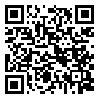Volume 78, Issue 10 (January 2021)
Tehran Univ Med J 2021, 78(10): 658-667 |
Back to browse issues page
Download citation:
BibTeX | RIS | EndNote | Medlars | ProCite | Reference Manager | RefWorks
Send citation to:



BibTeX | RIS | EndNote | Medlars | ProCite | Reference Manager | RefWorks
Send citation to:
Jalalzadeh A H, Shalbaf A, Maghsoudi A. Compensation of brain shift during surgery using non-rigid
registration of MR and ultrasound images. Tehran Univ Med J 2021; 78 (10) :658-667
URL: http://tumj.tums.ac.ir/article-1-10930-en.html
URL: http://tumj.tums.ac.ir/article-1-10930-en.html
1- Department of Biomedical Engineering, Science and Research Branch, Islamic Azad University, Tehran, Iran.
2- Department of Biomedical Engineering and Medical Physics, School of Medicine, Shahid Beheshti University of Medical Sciences, Tehran, Iran. ,shalbaf@sbmu.ac.ir
2- Department of Biomedical Engineering and Medical Physics, School of Medicine, Shahid Beheshti University of Medical Sciences, Tehran, Iran. ,
Abstract: (1796 Views)
Background: Surgery and accurate removal of the brain tumor in the operating room and after opening the scalp is one of the major challenges for neurosurgeons due to the removal of skull pressure and displacement and deformation of the brain tissue. This displacement of the brain changes the location of the tumor relative to the MR image taken preoperatively.
Methods: This study, which is done from March to December 2019 in Tehran, is evaluated on the available database of RetroSpective Evaluation of Cerebral Tumors (RESECT) including pre-operative MR images, and intra-operative ultrasound from 22 patients with low-grade gliomas who underwent surgeries at St. Olavs University Hospital. This study is used for image registration of preoperative MR imaging and ultrasound imaging after resection of the skull to compensate for brain changes. By this method, we obtained a third image that resembles preoperative MR imaging but has the geometry of the brain shape changes. We used a combination of the two transformations named Affine and non-rigid Free Form Deformation (FFD) for hierarchically moving the pixels to compensate for global variations, and also nonlinear local and small variations. Also, by applying the mutual information function, we consider the entropy value as the criterion of similarity due to the non-similarity of the nature of the images. Also, Limited Broyden-Fletcher-Goldfarb-Shannon method is used for optimization.
Methods: This study, which is done from March to December 2019 in Tehran, is evaluated on the available database of RetroSpective Evaluation of Cerebral Tumors (RESECT) including pre-operative MR images, and intra-operative ultrasound from 22 patients with low-grade gliomas who underwent surgeries at St. Olavs University Hospital. This study is used for image registration of preoperative MR imaging and ultrasound imaging after resection of the skull to compensate for brain changes. By this method, we obtained a third image that resembles preoperative MR imaging but has the geometry of the brain shape changes. We used a combination of the two transformations named Affine and non-rigid Free Form Deformation (FFD) for hierarchically moving the pixels to compensate for global variations, and also nonlinear local and small variations. Also, by applying the mutual information function, we consider the entropy value as the criterion of similarity due to the non-similarity of the nature of the images. Also, Limited Broyden-Fletcher-Goldfarb-Shannon method is used for optimization.
| Results: The results of the proposed method were presented on the available database of RetroSpective Evaluation of Cerebral Tumors (RESECT) including images of 22 patients with glioma type 2 tumors and evaluated based on 15 landmarks per patient and also mutual information criteria. The mean target registration error for affine, FFD and the proposed method are 46.19, 42.85 and 38.01, respectively. It was shown that the proposed method achieved high accuracy by combining the two transformations of affine and FFD compared to the separate use of each of the two models. Conclusion: In image registration of preoperative MR and ultrasound images for compensation of brain shift, the combination of affine and FFD transformations had better results than the individual use of each of the transformations. |
Type of Study: Original Article |
Send email to the article author
| Rights and permissions | |
 |
This work is licensed under a Creative Commons Attribution-NonCommercial 4.0 International License. |





